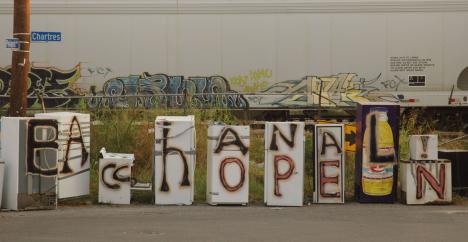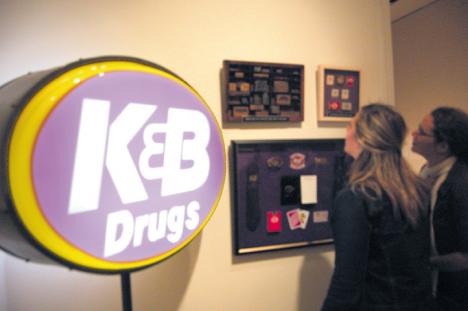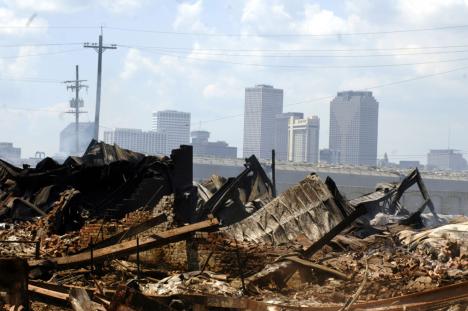Renowned Photographer David Rae Morris was called into action when Hurricane Katrina put a hold on a project that was more than three decades in the making. He embarked on a project with Phillip Collier who, like many before him, fell in love with New Orleans at an early age.
What Collier loved, however, was not the dime a dozen t-shirt shops, or the three-for-one happy hours, but the history itself. After 35 years, Collier compiled a book titled “Missing New Orleans,” a glimpse of the way things used to be.
Collier’s book, financially backed by the Ogden Museum of Southern Art, was set to print Aug. 31. But, with the events that happened two days prior to publication, the title, “Missing New Orleans,” adopted an entirely different meaning.
Morris’ work helped redefine the title and fill the void created by Katrina. His photographs can now be found both in Collier’s book and on display at the Ogden.
Morris evacuated to Jackson, Miss. with his family the Saturday before Katrina made landfall. After the storm slammed the Gulf Coast, Morris was overwhelmed with assignments from clients and papers such as The New York Times and USA Today.
The first few days following the storm Morris only traveled as far as the Mississippi Gulf Coast, visiting cities such as Waveland, Bay St. Louis and Pascagoula. “As soon as the storm passed I started itching. I wanted to go out there, ” Morris said. “But at the same time I wasn’t emotionally prepared to go back into New Orleans.”
By Saturday, Morris was ready and teamed up with colleagues Lorie Wselchuk, “the Energizer Bunny of photography,” and Tyrone Turner, a photographer for National Geographic, and together they re-entered New Orleans.
Using Turner’s press credentials to slip through checkpoints, the trio spent its days in the city and its nights back at Wselchuk’s apartment in Baton Rouge. Each night Morris would load his images onto his online gallery, and it wasn’t long before he was flooded with e-mails.
“People kept telling me that it was the best work that I’ve ever done,” said Morris, “and I didn’t understand because my style was the same.” It was the subject that was different.
It didn’t take long however for the people behind the book “Missing New Orleans,” to realize what the book was missing.
“My work was the last piece of the puzzle,” Morris said. “It fit.”
Representative, for both the book and the Ogden, Mary Beth Haskins said: “We immediately had to amend the book. The title conjured a whole new meaning.”
Production shifted and an epilogue was added. Morris’ work soon became the final chapter, and its display at the Ogden Museum of Southern Art has raised a few artistic brows.
Morris’ work is much different from other photographs of Katrina’s aftermath. It focuses less on the Superdome and convention center trauma and more on humanity in a broader sense.
“But is this art?” Morris asks. “The photographs were taken five months ago and we’re still living it. Do they already belong in a museum?”
“Absolutely,” Haskins said. “Not every aspect of art is pleasant.”
The motive behind Morris’ work was not to gain wealth or artistic prestige, but mainly to help him and others make sense of this extraordinary disaster.
“Going back into the city was very challenging emotionally,” said Morris. “But it was the only way for me to make sense of it all. I had to see it. I wanted to try to use my ability to communicate through photography and bring what I saw to others.”
Morris is still documenting devastated parts of New Orleans.
“I went to a church today in the ninth ward. It held 15 feet of water,” Morris said. “About three inches of dried muck was on the pews, and from where I was standing, I would see the choir loft. I closed my eyes and tried to imagine singing. Then I opened them … photography doesn’t do it justice.”
Morris wants to begin a gradual shift from Katrina-related work to something less emotionally draining.
“I can’t do it anymore,” said Morris, “You just can’t get used to it.”
The book, “Missing New Orleans” was released Nov. 19. The same night, the Ogden had a book signing with all of the contributing artists involved and opened its new ‘Missing’ exhibit to the public.
Expecting a more modest crowd, representatives from the Ogden were surprised when more than 600 people came through the doors that night. The line for the book stretched the length of the gift shop and all the way to the front door. Within four weeks, the entire stock was sold out.
“We haven’t printed anymore yet,” Haskins said. “But everyone seems to be wanting one.”
The Ogden has not yet resumed its pre-Katrina business hours. It is open Friday through Sunday from 11 a.m. to 4 p.m., and admission is five dollars. On Thursday nights, the Ogden is open from 6 to 8 p.m. for what is known as “Ogden After Hours,” with live music in the atrium and an open bar a few feet away. Admission is eight dollars for students and ten dollars general admission. The ‘Missing’ exhibit will be on display until March 26. The Ogden is located at 925 Camp St.
Jared Bailey can be reached jrbailey@loyno.edu.

David Rae Morris captures the lineup of the rotting refridgerators on the side of the road days after Hurricane katrina rolled through. (David Rae Morris)

Vintage K&B Drugstore memorabilia is displayed at the ´Missing New Orleans´ exhibit at the Ogden Museun of Southern Art at Lee Circle.






